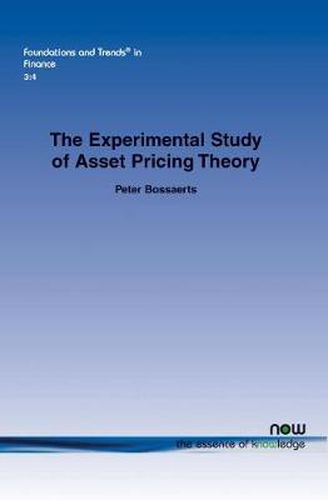Readings Newsletter
Become a Readings Member to make your shopping experience even easier.
Sign in or sign up for free!
You’re not far away from qualifying for FREE standard shipping within Australia
You’ve qualified for FREE standard shipping within Australia
The cart is loading…






This title is printed to order. This book may have been self-published. If so, we cannot guarantee the quality of the content. In the main most books will have gone through the editing process however some may not. We therefore suggest that you be aware of this before ordering this book. If in doubt check either the author or publisher’s details as we are unable to accept any returns unless they are faulty. Please contact us if you have any questions.
The Experimental Study of Asset Pricing Theory is the first review of experimentation in asset pricing, which is both rare and novel. The goal of experimentation is twofold. First, experimentation is meant to evaluate the science behind asset pricing theory. Second, the goal of experimentation is to come to a deeper understanding of asset pricing theory.
This book sets the stage by first examining a sample data set that looks very much like the typical data set finance scholars gather from the field, only it was actually generated in thelabouratory. It then moves on to discuss risk aversion, since asset pricing theory builds on risk aversion. The issue is - is there enough risk aversion in thelabouratory given typical levels of compensation? Asset pricing theory also builds on competitive equilibrium, but competitive equilibrium is an abstract notion; how can we get to it in thelabouratory?
The author builds on the path-breaking work of Vernon Smith and Charlie Plott who demonstrated that certain trading institutions indeed allow us to generate competitive equilibrium. The author then presents the main findings - first concerning simple static asset pricing models, moving on to dynamic pricing theory, and the implications of ambiguity aversion. Asset pricing theory rarely discusses how markets reach equilibrium, but experiments shed new light on price behavior during equilibration, as well as on off-equilibrium allocation dynamics. It also examines information aggregation and markets for loan and insurance contracts, where adverse selection may preclude equilibration, and even when not, the resulting allocations may be Pareto sub-optimal.
$9.00 standard shipping within Australia
FREE standard shipping within Australia for orders over $100.00
Express & International shipping calculated at checkout
This title is printed to order. This book may have been self-published. If so, we cannot guarantee the quality of the content. In the main most books will have gone through the editing process however some may not. We therefore suggest that you be aware of this before ordering this book. If in doubt check either the author or publisher’s details as we are unable to accept any returns unless they are faulty. Please contact us if you have any questions.
The Experimental Study of Asset Pricing Theory is the first review of experimentation in asset pricing, which is both rare and novel. The goal of experimentation is twofold. First, experimentation is meant to evaluate the science behind asset pricing theory. Second, the goal of experimentation is to come to a deeper understanding of asset pricing theory.
This book sets the stage by first examining a sample data set that looks very much like the typical data set finance scholars gather from the field, only it was actually generated in thelabouratory. It then moves on to discuss risk aversion, since asset pricing theory builds on risk aversion. The issue is - is there enough risk aversion in thelabouratory given typical levels of compensation? Asset pricing theory also builds on competitive equilibrium, but competitive equilibrium is an abstract notion; how can we get to it in thelabouratory?
The author builds on the path-breaking work of Vernon Smith and Charlie Plott who demonstrated that certain trading institutions indeed allow us to generate competitive equilibrium. The author then presents the main findings - first concerning simple static asset pricing models, moving on to dynamic pricing theory, and the implications of ambiguity aversion. Asset pricing theory rarely discusses how markets reach equilibrium, but experiments shed new light on price behavior during equilibration, as well as on off-equilibrium allocation dynamics. It also examines information aggregation and markets for loan and insurance contracts, where adverse selection may preclude equilibration, and even when not, the resulting allocations may be Pareto sub-optimal.